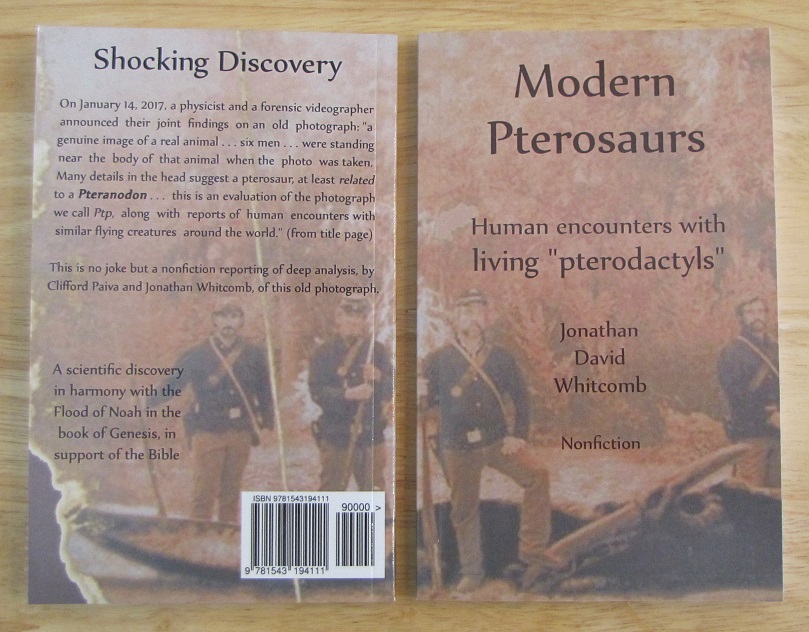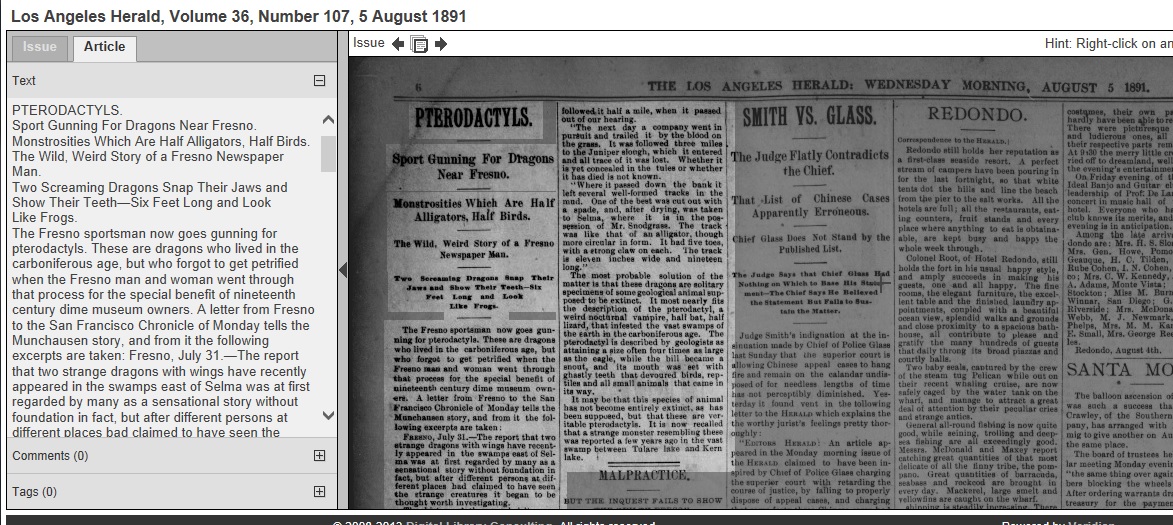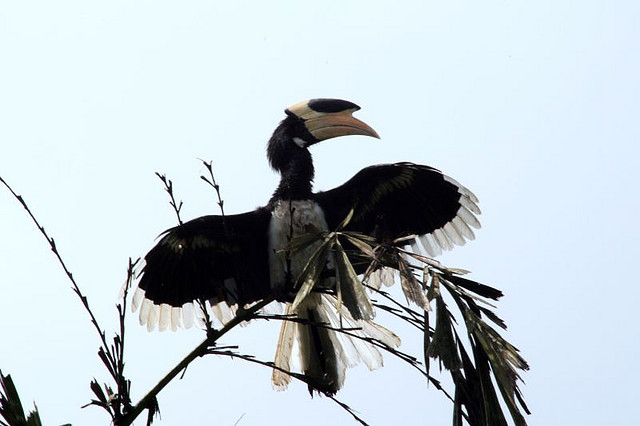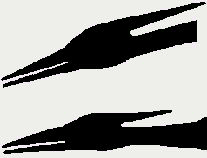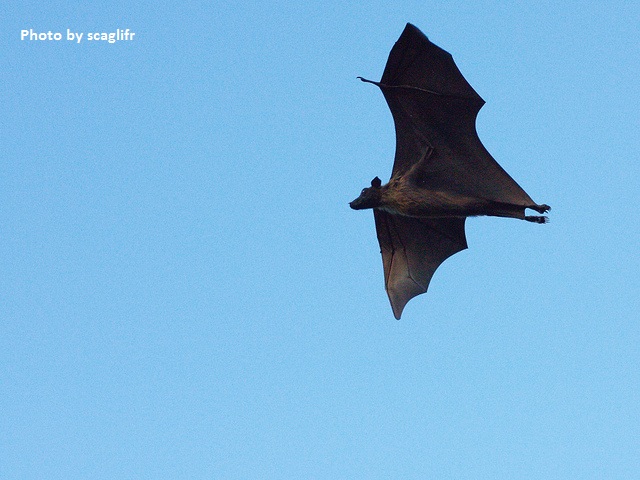By the modern-pterosaur expert Jonathan D. Whitcomb (published May 20, 2017)
We agree to disagree
Glen Kuban (GK) and I have a few things in common. We’ve both been writing about reports of apparent extant pterosaurs (or those who believe in them) for a long time, and we’ve written a lot. I started late in 2003; and GK, in 2004. We differ, however, in how we interpret those reports.
We acknowledge each other’s writings, having greatly disagreed on many points. We sometimes communicate, always in friendly terms, but our basic perspectives do not seem to change much over many years: He believes that no species of pterosaur has survived into the past few centuries; I believe that a number of species live today.
Nevertheless, we seem to agree to disagree without making any accusations of dishonesty and without any name calling. That’s a lot better than writings on other online publications, with other controversial subjects.
Even when we agree on something, we may choose to color the point of agreement differently. For example, we both see the 1856 Illustrated London News story as a hoax, yet I take it in a broader perspective. I see that fake newspaper article in the context of 19th century stories published in the USA, articles that may be more truthful, even as they report what appears to be the same thing: apparent “pterodactyls” that still fly.
.
An 1891 newspaper article about two “pterodactyls” or “dragons” in Central California
.
Kuban’s “Living Pterosaurs” article (GKLP): criticisms against LP investigations
No web page ever published online, on the subject of reports of possible extant pterosaurs, is likely to be nearly as long as Glen Kuban’s Living Pterosaurs (“pterodactyls”). As best as I can tell, the version published on May 18, 2017, has over 27,000 words [but see the update at the bottom of the post you are now reading]. That’s longer than my latest printed book: Modern Pterosaurs. As far as I know, when he notices an error of fact on GKLP (or when I point one out to him), he makes a correction, at least sometimes. But the main problem I see in his long article is not that kind of error. I see signs that point to both confirmation bias and belief perseverance, and that combination seems to me to cause a multitude of foundational mistakes in GKLP.
Belief perseverance
Let’s begin with some online writings of the cryptozoologist Dale Drinnon, who is mentioned 11 times in GKLP (May 18th version). A few years ago, I communicated with him regarding his interpretation of a sighting of a potential extant pterosaur in the Philippines: He thought it was an encounter with some kind of fish. He suggested the man in the Philippines had witnessed a stingray (or similar fish) jumping out of water rather than a pterosaur flying overhead.
I had written more than one blog post about that sighting, but one post was short. In that post, is said little except that the eyewitness went to some fishermen, who told them of their own experiences with that kind of flying creature. Because of that reference to fishermen, Dale Drinnon concluded that the original sighting was of a fish jumping out of water. In fact, Drinnon wrote about his interpretation of that sighting.
I communicated with that cryptozoologist, informing him that he had read only a partial account of the original report. A more complete account explained that the sighting was high above a city in the Philippines, not over any body of water. I assumed that this would solve the misunderstanding. How surprised I was when Drinnon still held onto his idea that it was a fish jumping out of water! Years later, I learned that this kind of reasoning error has a name: “belief perseverance.”
In other words, Mr. Drinnon read a partial account, assumed that it was a fish, then refused to change his mind, even after I had told him that the creature was flying over a city.
We need to acknowledge that a person who has once fallen into belief perseverance (or its cousin, confirmation bias) need not always fall into that faulty kind of reasoning. But when the same controversial subject comes up with someone who had once fallen into that kind of error, it can very well happen again. This seems to have happened with Mr. Drinnon.
Confirmation bias
To begin, I used to work with 2D animation, part time, in my own business in Southern California, although I used animation only on occasion and as more like a tool for other projects rather than as a general animation business. The point is this: I had experience with digital image manipulation software, including Photoshop.
Glen Kuban has mentioned Dale Drinnon 11 times in GKLP, in ways suggesting he is a trusted authority. GK has not, apparently, noticed any problem that DD has had with belief perseverance. I do not say or imply that the flying ray-fish conjecture never has any merit, but I do say that DD has fallen into faulty reasoning on at least one occasion with that idea. Since GK appears to support ideas by that cryptozoologist, I’ll mention another problem.
.
The old photograph that is now called “Ptp” – supported by two scientists as genuine
.
For several months, the physicist Clifford Paiva and I have examined the photo Ptp in detail, finding significant points of evidence that it is from before about the year 1870 and that the apparent animal shown in the image was a real animal. In addition, we have found weaknesses in criticisms that have been leveled against the photograph.
Drinnon has mentioned two points in the Ptp photograph that he has assumed are evidences of a Photoshop hoax. From the experiences I have had with Photoshop, and with other digital image manipulation software, I found those two points not only weak but completely wrong. Neither of them have any relationship to Photoshop manipulation.
Yet I needed to carefully examine those places in the photo, to see if Drinnon’s ideas had merit. I found that they completely failed. (One point was missing fingertips with a hand of the soldier on our far left; the other, an apparent “halo” above the head of another soldier.) He also made two other statements, other details that he assumed were evidences of a hoax. I found one of them questionable and the other one totally incorrect.
I then wondered how Drinnon had come to so many blunders in what he had assumed were evidences that Ptp was a hoax photo. The best explanation seems to be this: He fell into a confirmation bias.
Something caused him to assume Ptp was not a valid photograph of a modern pterosaur. He found several details, most of them in the soldiers rather than in the animal, and assumed they were evidence for what he already believed: that the photograph was a hoax. He then concluded that his evidence was valid and published his ideas online. Those points alone suggest he fell into a confirmation bias. Combine that with his previous problem with a belief perseverance and it seems even more likely that this was what happened.
Belief perseverance and confirmation bias with Glen Kuban
I believe that GK has fallen into similar errors in his “Living Pterosaurs” article, but I’ll not examine those possibilities in detail here except for one problem: He seems to assume that a significant number of the reported sightings could be misidentifications of common birds. That assumption seems to have caused him to see only a narrow range of interpretations for descriptions given in sighting reports of apparent pterosaurs.
.
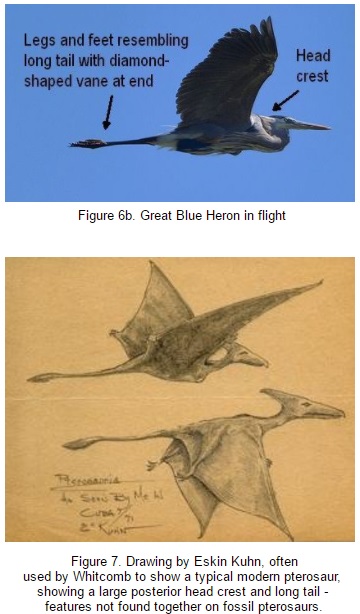
From “Living Pterosaurs” (online article by Glen Kuban)
The above images were taken directly from GKLP, without any change of perspective or spacing. Notice the problem with the Blue Heron conjecture: The sketch by Eskin Kuhn differs a great deal from the appearance of that bird. Notice the clear lack of feather in the lower image (EK sketch). Now see how the legs are built into the wings in that sketch.
I suggest that an objective observer would notice the great differences between the above two images and reject the Blue Heron conjecture in that case and be suspicious of its use for other sightings, unless a particular sighting seems relevant to the Blue Heron idea.
In addition, some of the eyewitnesses of apparent pterosaurs in the United States report that the flange at the end of the tail could not have been feet because the legs of the animal were clearly seen to be separate structures from the tail.
Conclusion
Protecting standard models that originated in the 19th century—that is no guarantee that the one trying to protect those ideas will not fall into confirmation bias or belief perseverance. How greatly we need careful objective evaluations of conflicting ideas, in particular regarding the possibility that at least some of the reported sightings of apparent living pterosaurs have come from actual encounters with that kind of flying creature!
Update: March 22, 2018, by Jonathan Whitcomb
Glen Kuban continues to expand his enormous web page “Living Pterosaurs (‘pterodactyls’)?” (GKLP) and, as far as I can see without devoting hours to researching all of it, probably continues to search for any reason that somebody may doubt that any species of pterosaur escaped extinction.
I now refer to a word count of GKLP, using the online tool found at Word Counter:
>>> Total words of “Living Pterosaurs” — 39,281
Some of the most common words under “Non-Common Keywords” are the following:
>>> whitcomb — 413 (number one)
>>> photo — 235 (number two)
>>> pterosaurs — 234 (number three)
>>> pterosaur — 233 (number four)
I point out the above to justify why I sometimes respond to Kuban’s online publication, for he mentions my name hundreds of times. Let’s take the above in context: The original version of the post you are now reading (published May 20, 2017), my own post, has the following, when submitted to Word Counter:
>>> Total words for the original post you are reading — 2023
Some of the most common words under “Non-Common Keywords” in this (Whitcomb’s response):
~~~ pterosaurs — 19 (number one)
~~~ sighting — 14 (number two)
etc.
Criticism or Lack Thereof
I don’t suggest any dramatic judgment in the above comparisons, with any criticism of the quality of GKLP or any promotion of the quality of my post here; draw whatever conclusions you will. But I do emphasize the enormous size of Kuban’s page. It has nineteen times the word count of the original post I wrote above, according to Word Counter, and if I am only partially correct in my evaluation of his lack of objectiveness then many of his readers can be greatly led away from the truth regarding eyewitness sighting reports of living pterosaurs.
Paleontology or Cryptozoology?
By writing what appears to be the longest online publication, in the world of the internet, on the subject of living pterosaurs, Kuban has inadvertently wandered, in my opinion, into the realm of cryptozoology. As far as I can tell he is really either a paleontologist or an amateur in the field of paleontology, not a cryptozoologist.
What is one of the primary tools used in cryptozoology? Interviewing an eyewitness. Mr. Kuban, on the other hand, has made it clear that he does not use that tool and appears to have no desire to ever use it. In the latest version of GKLP he states, “many alleged eyewitnesses are probably sincere, so there would probably be little to gain from seeking contact with them.”
I don’t recall anywhere in his “Living Pterosaurs” publication where he states that he is a scientist; In my own publications, I sometimes mention that I am a scientist. Yet what is the origin of modern Western science? Was it not in the search for explanations for human experience? If only people would remember that!
Real science should include trying to come to objective and realistic explanations for what people experience. Don’t try to explain away what people see, to protect old assumptions: Allow new discoveries to be made.
###
Copyright 2017, 2018 Jonathan David Whitcomb
.
Potential Bias and Objectiveness
“To pretend that a real scientist will speak only words of objective truth, with no hint of personal philosophy, is like swimming through images of a 1950’s science fiction movie. Every adult who is not mentally disabled promotes some point of a personal philosophy, almost with every word spoken or written.” [quotation from the fourth edition of the cryptozoology book Searching for Ropens and Finding God]
.
Photographie d’un ptérosaure moderne
Avant environ l’année 1870, l’enregistrement d’une photo a pris beaucoup de secondes. Les gens devaient rester immobiles pendant plusieurs secondes. Les accessoires ont été utilisés pour aider les gens à ne pas bouger. Ce type de prop est vu dans Ptp. Il fait partie d’une branche d’un arbre.
.
The Pteranodon Photo and Religion
Religion is related to the “Pteranodon” photograph that is now called “Ptp,” but those skeptical comments from critics who assume extreme bias in all Christian supporters of living-pterosaur investigations—those critical comments are incorrect. Paiva and I have looked carefully at this photo, with an open mind about various possibilities of hoaxing. Ptp has survived the close scrutiny extremely well.
.
That’s a hoax-photo, made to promote the Freakylinks TV series that aired on the Fox Network from 2000-2001. The photo on the left, however, is older, apparently seen by many readers of a book in the mid-20th century. With that knowledge, it’s easy to see that the Freakylinks hoax was made to imitate the older photograph.
.
Advertisement:
.
The nonfiction cryptozoology book Modern Pterosaurs—the shocking truth about extant “pterodactyls”
.



